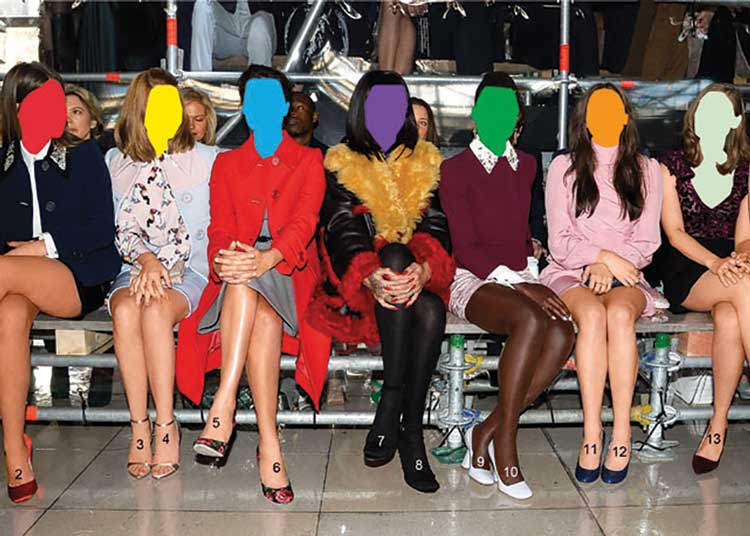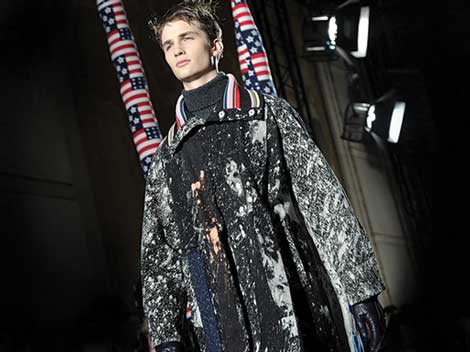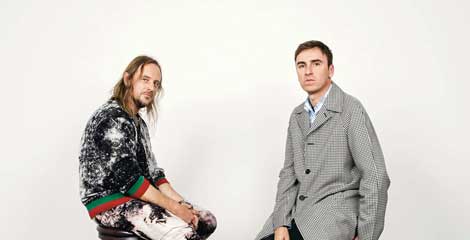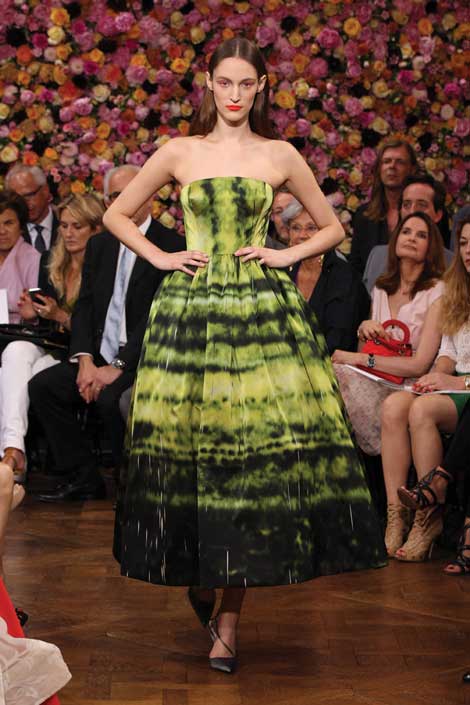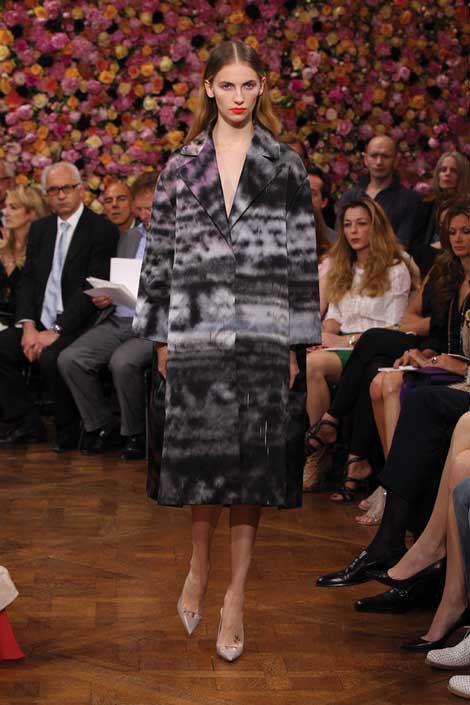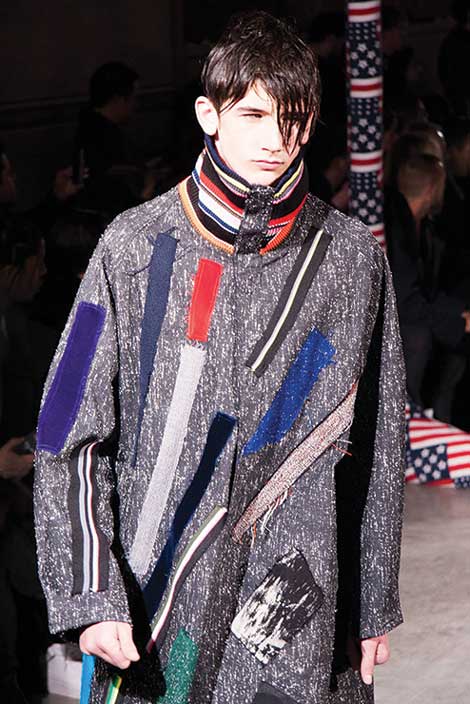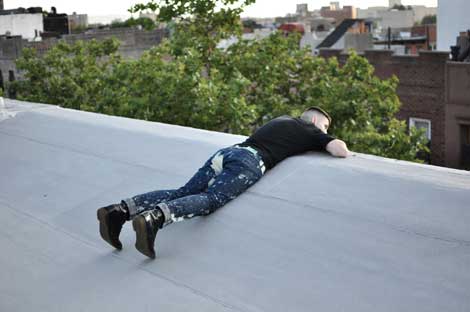Is fashion the medium of the moment? I’m not talking about haute couture or luxury ready-to-wear fashion design. Since the ascendance of Conceptualism, the means of fabrication have been more or less beside the point in fine art; and so it would be here. This isn’t about elevating design, or even architecture—and all the materials, craft and engineering that sustain it—to the status of art. It’s about fashion itself—the kinescopic parade of style packaging and costuming loosely wedded to the evolving human form in motion, and the entire machinery of craft/industrial processes and commercial apparatus that sustains and cycles through it. In other words—is Fashion simply the biggest Conceptual Constructivist kinetic sculpture of all time?
Consider an image from a recent portfolio of prints by that godfather of Conceptualism himself, John Baldessari. The image was a fashion show front row (Miu Miu)—presumably the typical mix of high-profile editors, “of the moment” celebrities, powerhouse buyers and a high-profile client or two—with the faces (and necks) of all but one flattened behind Baldessari’s patented primaries and secondaries, while the insteps of their feet are consecutively numbered 1 through 16, drawing our attention to the shoes, as if the shoes were themselves the runway looks, and—dare I say it?—the fashion. It’s pure Baldessari—flattened, fungible; the “arbitraries” pronounced yet subtle (heads inclined at variance with the runway “action,” yet with hands similarly folded just so in each lap). But it’s the fashion that “defies the hand(s)” here—both the artist’s and the forces that propelled the participants into this array. The fashion is what mixes it up, messes with us—and maybe with Baldessari, too.
It’s a striking turnaround for Baldessari, who seemed to keep a somewhat chilly distance from the fashion world when I interviewed him in 2010. But along came Hedi Slimane, who, after his celebrated “skinny-suit” stint at Dior Homme, had decamped to California and returned to his career as a photographer. Slimane was deeply immersed in photography long before entering the fashion world and had continued working in the field off and on alongside his thriving design career and its occasional interruptions. In 2011, he curated “California Dreamin’: Myths and Legends of Los Angeles,” for the Almine Rech Gallery in Paris, a show that featured the work of John Baldessari.
If the inclusion of artists like Baldessari, Ruscha and Burden seemed almost reflexively ready-made, Slimane’s other choices (e.g., Raymond Pettibon, Mark Hagen, Patrick Hill) reflected a serious engagement with Los Angeles art-making. (And not without risk: Pettibon scathingly pilloried both art and fashion domains in his portfolio for the house.)
The simple fact, lost amid splashy promotional campaigns and the explosive hype, is that commercial designers have been influenced and inspired by artists since the beginning of the 20th century (and probably long before: Consider Dali’s collaborations with Schiaparelli and Chanel). More importantly, designers may themselves be artists (and vice versa). And successful designers certainly collect art—as Raf Simons had been doing long before he came across the work of Sterling Ruby (this would have been around the time of Ruby’s “SuperMax” show with Marc Foxx in 2005). Simons arranged a visit to Ruby’s studio, eventually purchased a piece; and so began, as the movies might have it, a “beautiful friendship.”
“We’re good friends, but I was slightly worried that a full collaboration could change that,” Ruby commented a month ago—not long after Raf Simons had presented his third Spring-Summer ready-to-wear collection for Dior—where Ruby’s influence has also left its distinct imprint. (Simons more or less transliterated some of Ruby’s “spray” paintings into fabrics created for the Fall-Winter 2012 haute couture collection for the house.) But it is in Simons’ own eponymous design collections where Ruby’s influence and impact have been most sustained.
The blur between the domains of art and design is perhaps best illustrated by Ruby’s own studio practice. Ruby is not alone in his use of fabrics, dyes, needle craft and other elements traditionally associated with garment or design industries. But he was quick to see the possibilities for recycling and repurposing scraps and remnants into—what else? Raf Simons, whose work for both his original Antwerp company, as well as Jil Sander and, in a more historically contextualized framework at Christian Dior, has embraced a deconstructivist approach to design and couture, would have been quick to seize upon the possibilities in these strips and stripes, ladders and lattices. But Ruby was already one step ahead of him: “Raf’s been visiting the studio for years now and caught glimpses of the clothes I wear while working at the studio. I was making my own shirts and pants at the time using remnants of hand-dyed and bleached textiles that were from previous sculptures and paintings.”
Ruby’s first collaboration for the Raf Simons line would seem like a natural outflow of these kinds of shirts and pants—a “capsule” collection in denim “for which I treated and bleached all of the denim.” But his first commission was actually the interior of the Raf Simons flagship in Tokyo, the disorienting and marmoreal look of which partially derives from a series of lambda prints also made in 2007, “Fait Accompli/Bleach Inversion” (exhibited that year at Metro Pictures). “I inverted images of the bleached fabric, making a negative. It felt very photographic to me.”
In the meantime, Simons’ own career was taking its own vertiginous turns. Little more than a month after his abrupt termination from Jil Sander in March 2012, he was named creative director for Christian Dior. Ruby seems to play down the significance of Simons’ adaptation of three of his spray paintings into dresses (and one coat). But their presence in that debut collection spoke volumes—a kind of 21st-century response to Saint Laurent’s 1965 Mondrian dress. As Ruby himself observed, “[Simons] is so aware of Dior’s history and taps into what feels necessary for the moment.”
This touches on a larger dimension to the wave of art-fashion collaborations. It would be more accurate to call it a convergence. The best artists and designers are reaching out to engage something larger than what has traditionally been their core audience or clientele, or even the larger sphere of their cultural influence. The Baldessari imagery in those Saint Laurent dresses is no mere coincidence. This is about something tactile and willfully provocative. It’s about connecting with the immediate moment, but also something more enduring and resonant; as Rick Owens (who once designed in LA, but has been based in Paris since 2003) might put it, “something eternal.” Which is not to say it always works on a practical level.
“I know that we were both apprehensive in the beginning to do something like this because art and fashion/fashion and art do not always work together. We were very aware of the artist-designer collaborations from the past and we wanted to do something different. We wanted to make it a true Bauhaus effort.”
The reference to Walter Gropius’ visionary school for arts, crafts and technology is not fortuitous. “My favorite art historical moment was the Bauhaus movement. It shook things up from a utilitarian versus a non-utilitarian perspective, it challenged craft to be high art and vice versa.”
The Simons-Ruby collaboration took the Bauhaus unified aesthetic approach bicontinental.
“I think we were both surprised how natural it felt, we turned both of our studios into one, Los Angeles and Antwerp. We made drawings, hand-bleached, painted and dyed fabrics. We rendered designs and graphics, texted, called, emailed; and racked up a huge DHL bill by sending things back and forth—day in, day out—for months.”
Ruby would be the first to acknowledge that there is an ocean-sized chasm between an artist’s studio and the scale of a design operation like Simons’. “When I make my clothes and textiles at the studio I’m working with a small team and only one seamstress making unique one-off pieces. What Raf does is on a whole different scale and … the process was fascinating to me.”
Nevertheless, Ruby’s involvement in the final execution extended to fittings and final runway presentation. “The week before the show we set up our studio in Paris and worked through the looks, changes for the collection and fittings. We worked on finalizing models and the runway presentation, which included the hanging “VAMPIRES” [gaping fabric maws with dripping “fangs”]. We mixed music, starting with Pink Floyd’s Dark Side of the Moon and ending with that screaming guitar solo from Brian Eno’s “Baby’s On Fire.” It was an in-depth process.”
The immersive aspect of the Ruby-Simons collaboration sets it apart from more typical collaborations and commissions from fabric design to decors, runway theatrics and promotional graphics. It also epitomizes not only the unified aesthetic approach with its echoes of the Bauhaus, but a kind of unified media approach in which artists and designers are working through their ideas in many different media and across several media platforms.It also reflects a postconceptual level of engagement of artists both with their materials and much larger audiences for their work. “I don’t compartmentalize these ideas despite what might appear commercial to some. I still think that Raf and I took a big risk doing what we did together, collaboratively, and for me that is the success of it. I also think that it is hypocritical to say that art is a less commercial domain than fashion. I enjoy the fact that a huge portion of people who cannot have an artwork due to cost or space can have a garment. I also like that this is more akin to how I first understood visual culture. I wore what I did and still do because it has an aesthetic that expresses an attitude.”

